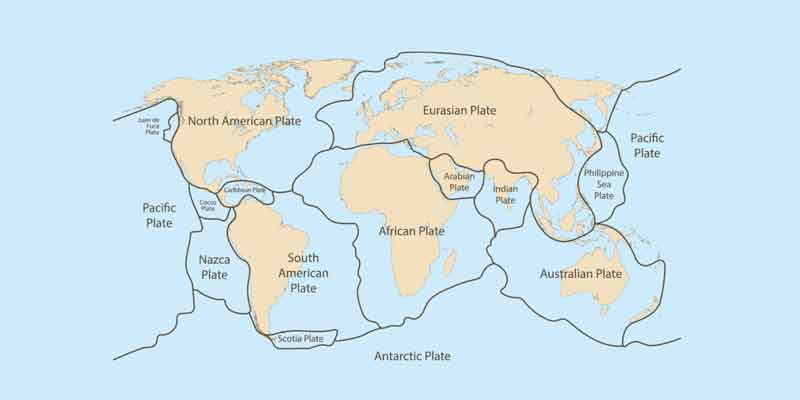A tectonic plate is a massive, irregularly-shaped slab of solid rock usually composed of both continental and oceanic lithosphere. Every continent is a part of a plate, and many experts have proposed that these continental plates keep moving resulting in the movement of the continents. This is what frames the theory of plate tectonics.
Plate Tectonic Theory
The theory of plate tectonics proposes that the earth’s lithosphere is divided into seven major and some minor plates. Young fold mountain ridges, trenches and faults surround these major plates. The plates move horizontally over the asthenosphere as rigid units, and these plates have been constantly moving over the globe throughout the history of the earth.
Since the advent of the concept of seafloor spreading, the interest in the problem of distribution of oceans and continents was revived. It was in 1967, McKenzie, Parker and Morgan independently collected the available ideas and came out with another concept termed Plate Tectonics.
A tectonic plate, also known as a lithospheric plate, is a massive slab of solid rock consisting of continental and oceanic lithosphere. Continents are part of a plate and they move with the plates.
Major Tectonic Plates
- Antarctica and the surrounding oceanic plates
- North American plate (with the western Atlantic floor separated from the South American plate along the Caribbean islands)
- South American plate (with the western Atlantic floor separated from the North American plate along the Caribbean islands)
- Pacific plate
- India-Australia-New Zealand plate
- Africa with the eastern Atlantic floor plate
- Eurasia and the adjacent oceanic plate.

Minor Tectonic Plates
- Cocos plate: Between Central America and the Pacific plate
- Nazca plate: Between South America and the Pacific plate
- Arabian plate: Mostly the Saudi Arabian landmass
- Philippine plate: Between the Asiatic and Pacific plate
- Caroline plate: Between the Philippine and Indian plates (North of New Guinea)
- Fuji plate: Northeast of Australia.
Theory of Plate Tectonics
These plates have been constantly moving over the globe throughout the history of the earth. It is not the continent that moves as believed by Alfred Wegener according to his Continental Drift Theory. Continents are part of a plate and what moves is the plate.
It may be noted that all the plates have moved in the geological past, and shall continue to move in the future as well. Wegener had thought of all the continents to have initially existed as a supercontinent in the form of PANGAEA.
However, later discoveries reveal that the continental masses, resting on the plates, have been wandering all through the geological period, and Pangaea was a result of the converging of different continental masses that were parts of one or the other plates.
Types of Plate Boundaries
There are three types of plate boundaries.
1. Divergent Boundaries: Where a new crust is generated as the plates pull away from each other. The sites where the plates move away from each other are called spreading sites.
2. Convergent Boundaries: Where the crust is destroyed as one plate dives under another. The location where the sinking of a plate occurs is called the subduction zone.
3. Transform Boundaries: Where the crust is neither produced nor destroyed as the plates slide horizontally past each other.
Rate of Plate Movement
The strips of the normal and reverse magnetic fields that parallel the mid-oceanic ridges help scientists determine the rates of plate movement. These rates vary considerably.
The Arctic Ridge has the slowest rate (less than 2.5 cm/yr), and the East Pacific Rise near Easter Island, in the South Pacific about 3,400 km west of Chile, has the fastest rate (more than 15 cm/yr).


![UPSC PSIR Optional Syllabus [PDF] Political Science and International Relations PSIR Optional Syllabus UPSC Exam](https://study925.com/wp-content/uploads/2023/02/PSIR-Syllabus-UPSC-.jpeg)



1 thought on “Plate Tectonic Theory UPSC Geography Notes”